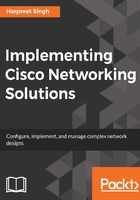
上QQ阅读APP看书,第一时间看更新
IOS command modes
The Cisco IOS command-line interface is divided into different command modes. Each command mode has its own set of commands for the configuration, maintenance, and monitoring of the router and network operations. The commands available depend upon the mode of the CLI, and can be queried by entering the question mark symbol (?) at the CLI prompt. CLI commands can be used to navigate from one mode to another within the IOS CLI.
The different modes of the Cisco IOS CLI are described as follows:
- Setup mode: This mode is used for the initial setup of the Cisco router/switch and provides an interactive mode for entering the basic parameters required for configuring the Cisco device through the system configuration dialog. If the system does not find any configuration file stored in the NVRAM, it prompts if the user wants to enter the setup mode, and use the system configuration dialog. If the user declines, the router enters the User EXEC mode. The user can use the setup command in the Privileged EXEC mode.
- User EXEC mode: This is the mode the router enters upon a normal uninterrupted boot sequence. This mode provides a very limited subset of commands primarily for connectivity and accessing the basic system information. The commands at this level do not change the configuration of the router. The commands available in this mode can be changed through router configuration. On a working device, a user enters this mode when he connects using a console terminal.
- Privileged EXEC mode: This mode is entered using the enable command at the User EXEC prompt, and requires a password to be accessed. This is the mode where all show commands can be run on the IOS CLI. The user can run debug commands on the router in this mode. However, this mode still does not allow the commands that can make changes to the router configuration, but one can enter the configuration mode using a command at this level. Users can return to the User EXEC mode using the exit command at this prompt.
- Global configuration mode: This mode is entered from the Privileged EXEC mode by using the configure terminal command. This mode requires an additional password to be accessed. The commands in this mode can be used to change the router configuration. There are multiple hierarchies within the global configuration level, for example, interface configuration mode, subinterface configuration mode, protocol configuration modes, and feature specific configuration modes. The commands available would depend on the feature set available on the router IOS version.
- ROM monitor mode: This mode is used when the router cannot boot properly. If the device does not find a valid system image to load when it is booting, the system will enter ROM monitor mode. ROM monitor (ROMMON) mode can also be accessed by interrupting the boot sequence during startup. This mode is primarily used for advanced troubleshooting.
The following figure provides a pictorial view of the main command modes used in the Cisco IOS CLI:

Figure 6: Cisco IOS modes